Psychology 4: Top-Down and Bottom-Up Processing of Perception Essay
VerifiedAdded on 2021/04/17
|8
|2258
|196
Essay
AI Summary
This essay explores the psychological principles of perception, focusing on the top-down and bottom-up processing approaches. It examines how humans interpret sensory information to interact with their environment, referencing the theories of Gibson and Gregory. The essay contrasts the direct, data-driven bottom-up approach, which relies on sensory input, with the indirect, knowledge-based top-down approach, which incorporates prior experiences and cognitive factors. It discusses Gibson's direct perception theory, including concepts like affordance and optical flow patterns, and contrasts it with Gregory's indirect theory, which emphasizes the role of past knowledge in visual illusions. The essay also highlights how both approaches work together in everyday perception and visual tasks. The essay further explores the role of visual illusions and the interplay between the two approaches, providing a comprehensive understanding of visual perception processes.
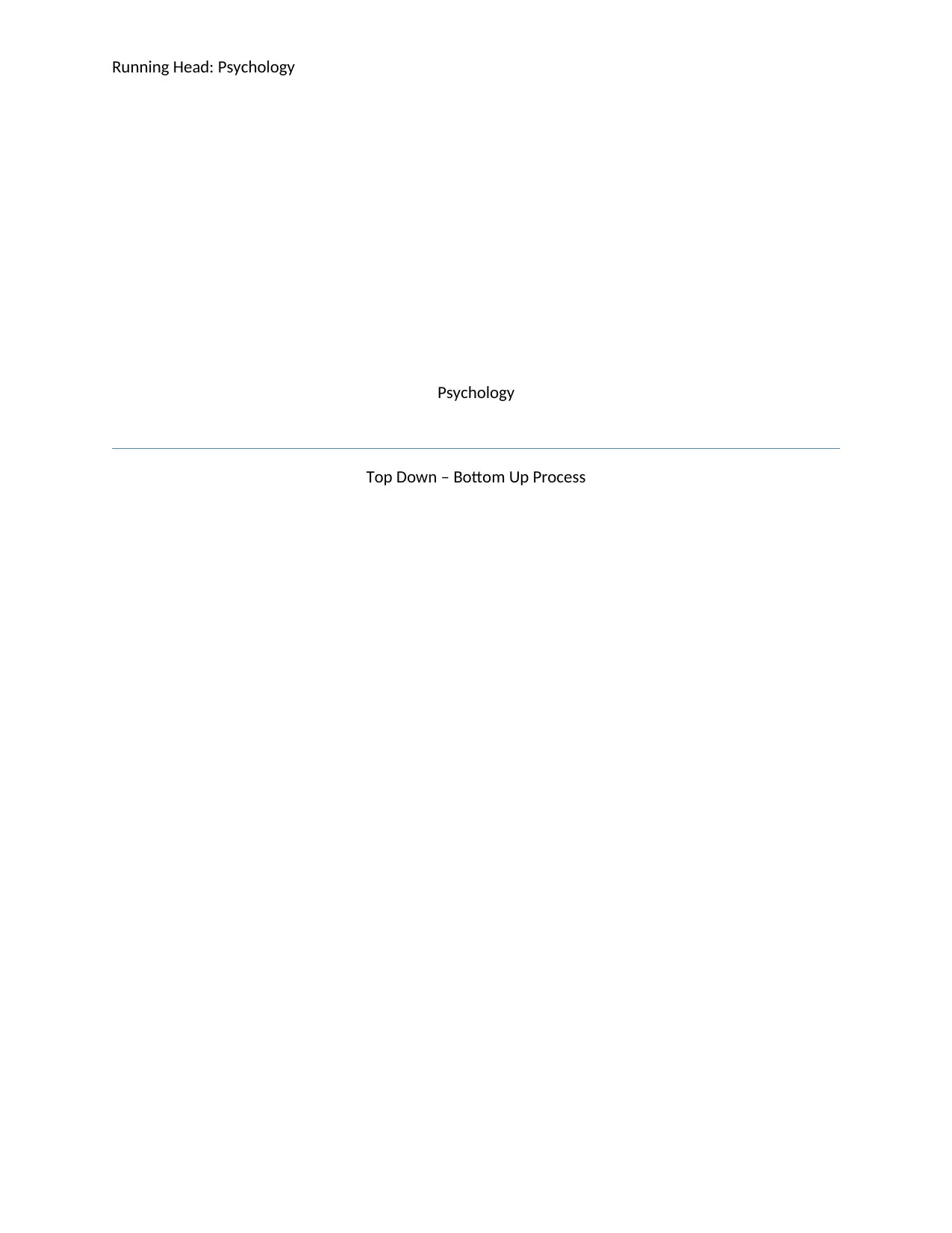
Running Head: Psychology
Psychology
Top Down – Bottom Up Process
Psychology
Top Down – Bottom Up Process
Paraphrase This Document
Need a fresh take? Get an instant paraphrase of this document with our AI Paraphraser
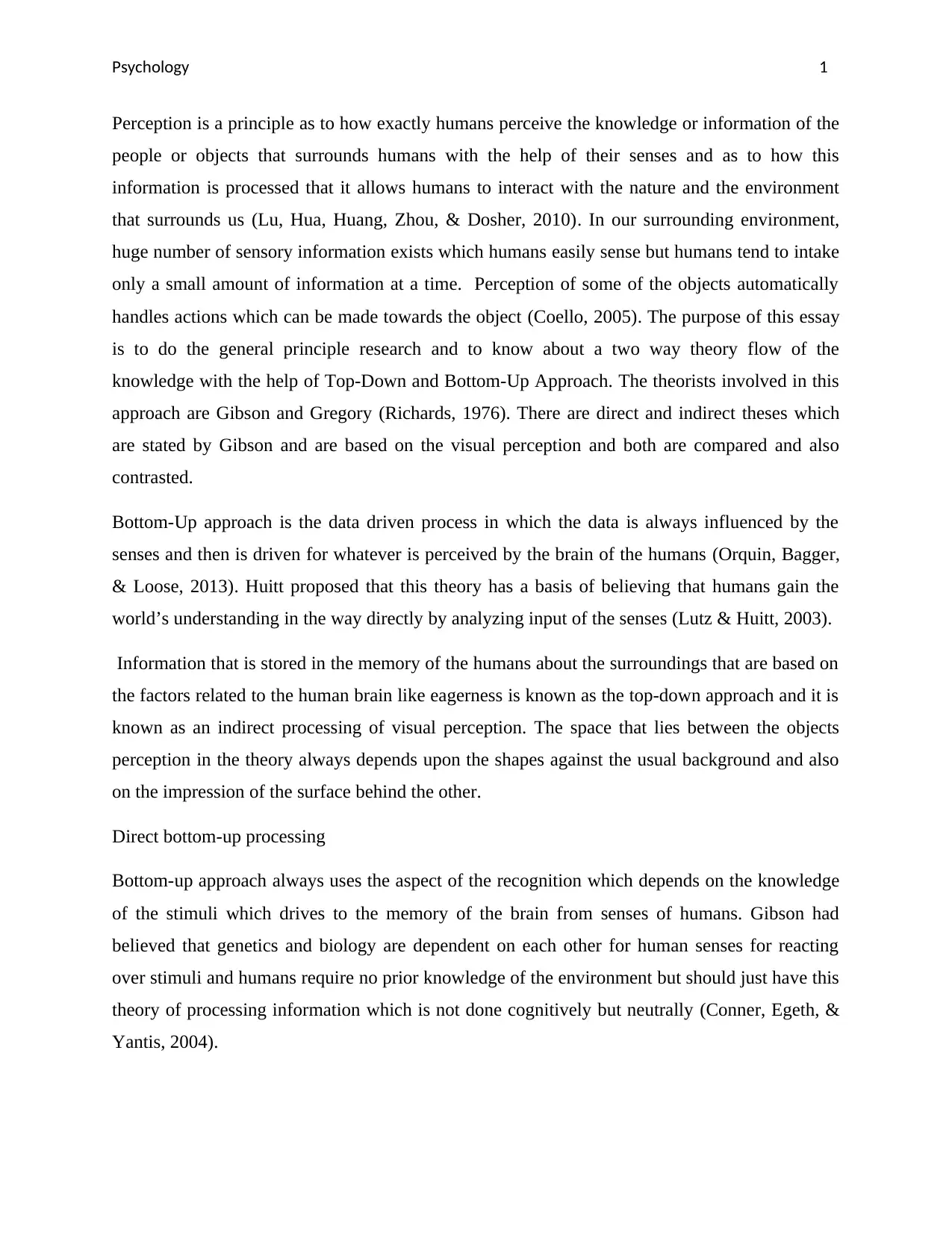
Psychology 1
Perception is a principle as to how exactly humans perceive the knowledge or information of the
people or objects that surrounds humans with the help of their senses and as to how this
information is processed that it allows humans to interact with the nature and the environment
that surrounds us (Lu, Hua, Huang, Zhou, & Dosher, 2010). In our surrounding environment,
huge number of sensory information exists which humans easily sense but humans tend to intake
only a small amount of information at a time. Perception of some of the objects automatically
handles actions which can be made towards the object (Coello, 2005). The purpose of this essay
is to do the general principle research and to know about a two way theory flow of the
knowledge with the help of Top-Down and Bottom-Up Approach. The theorists involved in this
approach are Gibson and Gregory (Richards, 1976). There are direct and indirect theses which
are stated by Gibson and are based on the visual perception and both are compared and also
contrasted.
Bottom-Up approach is the data driven process in which the data is always influenced by the
senses and then is driven for whatever is perceived by the brain of the humans (Orquin, Bagger,
& Loose, 2013). Huitt proposed that this theory has a basis of believing that humans gain the
world’s understanding in the way directly by analyzing input of the senses (Lutz & Huitt, 2003).
Information that is stored in the memory of the humans about the surroundings that are based on
the factors related to the human brain like eagerness is known as the top-down approach and it is
known as an indirect processing of visual perception. The space that lies between the objects
perception in the theory always depends upon the shapes against the usual background and also
on the impression of the surface behind the other.
Direct bottom-up processing
Bottom-up approach always uses the aspect of the recognition which depends on the knowledge
of the stimuli which drives to the memory of the brain from senses of humans. Gibson had
believed that genetics and biology are dependent on each other for human senses for reacting
over stimuli and humans require no prior knowledge of the environment but should just have this
theory of processing information which is not done cognitively but neutrally (Conner, Egeth, &
Yantis, 2004).
Perception is a principle as to how exactly humans perceive the knowledge or information of the
people or objects that surrounds humans with the help of their senses and as to how this
information is processed that it allows humans to interact with the nature and the environment
that surrounds us (Lu, Hua, Huang, Zhou, & Dosher, 2010). In our surrounding environment,
huge number of sensory information exists which humans easily sense but humans tend to intake
only a small amount of information at a time. Perception of some of the objects automatically
handles actions which can be made towards the object (Coello, 2005). The purpose of this essay
is to do the general principle research and to know about a two way theory flow of the
knowledge with the help of Top-Down and Bottom-Up Approach. The theorists involved in this
approach are Gibson and Gregory (Richards, 1976). There are direct and indirect theses which
are stated by Gibson and are based on the visual perception and both are compared and also
contrasted.
Bottom-Up approach is the data driven process in which the data is always influenced by the
senses and then is driven for whatever is perceived by the brain of the humans (Orquin, Bagger,
& Loose, 2013). Huitt proposed that this theory has a basis of believing that humans gain the
world’s understanding in the way directly by analyzing input of the senses (Lutz & Huitt, 2003).
Information that is stored in the memory of the humans about the surroundings that are based on
the factors related to the human brain like eagerness is known as the top-down approach and it is
known as an indirect processing of visual perception. The space that lies between the objects
perception in the theory always depends upon the shapes against the usual background and also
on the impression of the surface behind the other.
Direct bottom-up processing
Bottom-up approach always uses the aspect of the recognition which depends on the knowledge
of the stimuli which drives to the memory of the brain from senses of humans. Gibson had
believed that genetics and biology are dependent on each other for human senses for reacting
over stimuli and humans require no prior knowledge of the environment but should just have this
theory of processing information which is not done cognitively but neutrally (Conner, Egeth, &
Yantis, 2004).
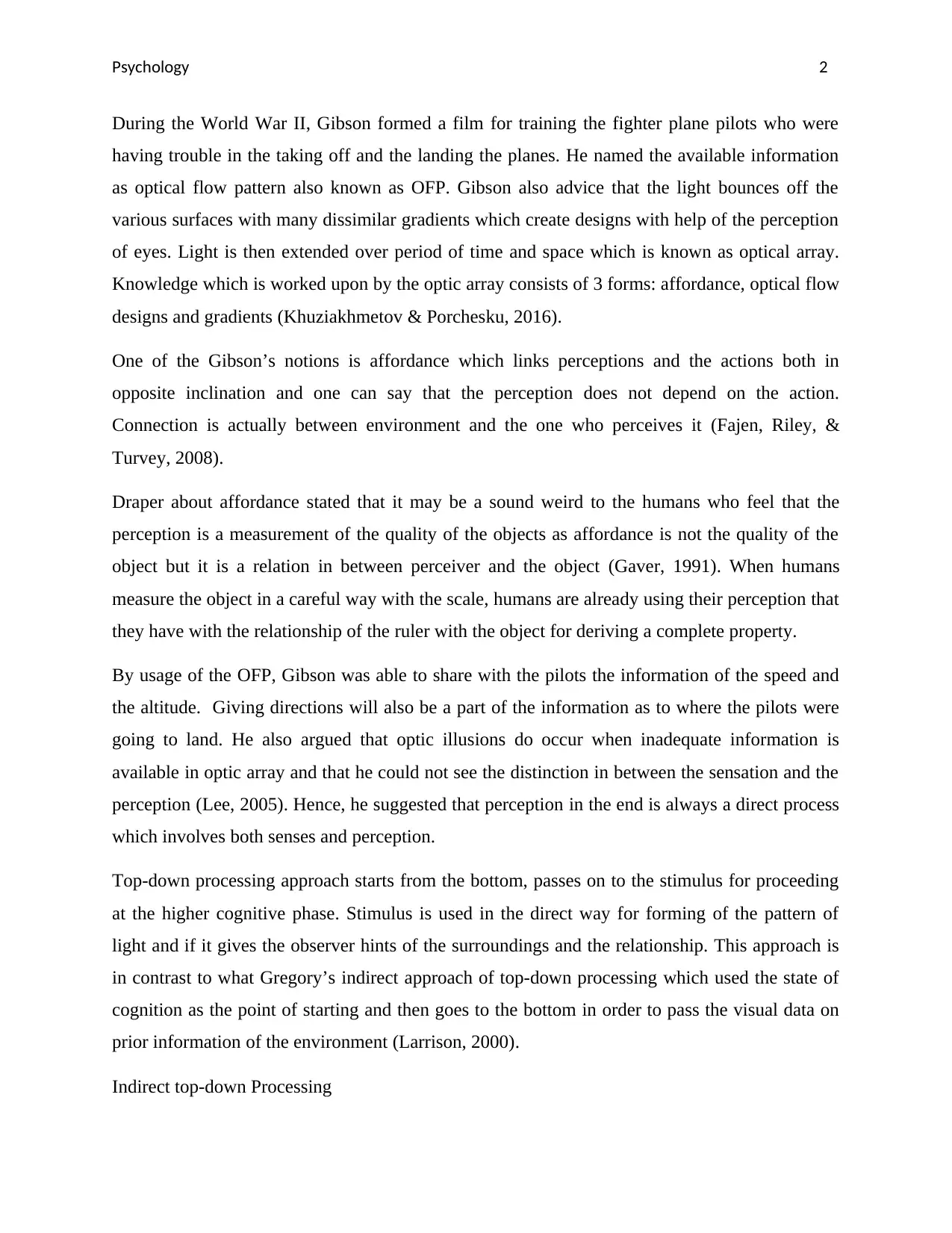
Psychology 2
During the World War II, Gibson formed a film for training the fighter plane pilots who were
having trouble in the taking off and the landing the planes. He named the available information
as optical flow pattern also known as OFP. Gibson also advice that the light bounces off the
various surfaces with many dissimilar gradients which create designs with help of the perception
of eyes. Light is then extended over period of time and space which is known as optical array.
Knowledge which is worked upon by the optic array consists of 3 forms: affordance, optical flow
designs and gradients (Khuziakhmetov & Porchesku, 2016).
One of the Gibson’s notions is affordance which links perceptions and the actions both in
opposite inclination and one can say that the perception does not depend on the action.
Connection is actually between environment and the one who perceives it (Fajen, Riley, &
Turvey, 2008).
Draper about affordance stated that it may be a sound weird to the humans who feel that the
perception is a measurement of the quality of the objects as affordance is not the quality of the
object but it is a relation in between perceiver and the object (Gaver, 1991). When humans
measure the object in a careful way with the scale, humans are already using their perception that
they have with the relationship of the ruler with the object for deriving a complete property.
By usage of the OFP, Gibson was able to share with the pilots the information of the speed and
the altitude. Giving directions will also be a part of the information as to where the pilots were
going to land. He also argued that optic illusions do occur when inadequate information is
available in optic array and that he could not see the distinction in between the sensation and the
perception (Lee, 2005). Hence, he suggested that perception in the end is always a direct process
which involves both senses and perception.
Top-down processing approach starts from the bottom, passes on to the stimulus for proceeding
at the higher cognitive phase. Stimulus is used in the direct way for forming of the pattern of
light and if it gives the observer hints of the surroundings and the relationship. This approach is
in contrast to what Gregory’s indirect approach of top-down processing which used the state of
cognition as the point of starting and then goes to the bottom in order to pass the visual data on
prior information of the environment (Larrison, 2000).
Indirect top-down Processing
During the World War II, Gibson formed a film for training the fighter plane pilots who were
having trouble in the taking off and the landing the planes. He named the available information
as optical flow pattern also known as OFP. Gibson also advice that the light bounces off the
various surfaces with many dissimilar gradients which create designs with help of the perception
of eyes. Light is then extended over period of time and space which is known as optical array.
Knowledge which is worked upon by the optic array consists of 3 forms: affordance, optical flow
designs and gradients (Khuziakhmetov & Porchesku, 2016).
One of the Gibson’s notions is affordance which links perceptions and the actions both in
opposite inclination and one can say that the perception does not depend on the action.
Connection is actually between environment and the one who perceives it (Fajen, Riley, &
Turvey, 2008).
Draper about affordance stated that it may be a sound weird to the humans who feel that the
perception is a measurement of the quality of the objects as affordance is not the quality of the
object but it is a relation in between perceiver and the object (Gaver, 1991). When humans
measure the object in a careful way with the scale, humans are already using their perception that
they have with the relationship of the ruler with the object for deriving a complete property.
By usage of the OFP, Gibson was able to share with the pilots the information of the speed and
the altitude. Giving directions will also be a part of the information as to where the pilots were
going to land. He also argued that optic illusions do occur when inadequate information is
available in optic array and that he could not see the distinction in between the sensation and the
perception (Lee, 2005). Hence, he suggested that perception in the end is always a direct process
which involves both senses and perception.
Top-down processing approach starts from the bottom, passes on to the stimulus for proceeding
at the higher cognitive phase. Stimulus is used in the direct way for forming of the pattern of
light and if it gives the observer hints of the surroundings and the relationship. This approach is
in contrast to what Gregory’s indirect approach of top-down processing which used the state of
cognition as the point of starting and then goes to the bottom in order to pass the visual data on
prior information of the environment (Larrison, 2000).
Indirect top-down Processing
⊘ This is a preview!⊘
Do you want full access?
Subscribe today to unlock all pages.

Trusted by 1+ million students worldwide
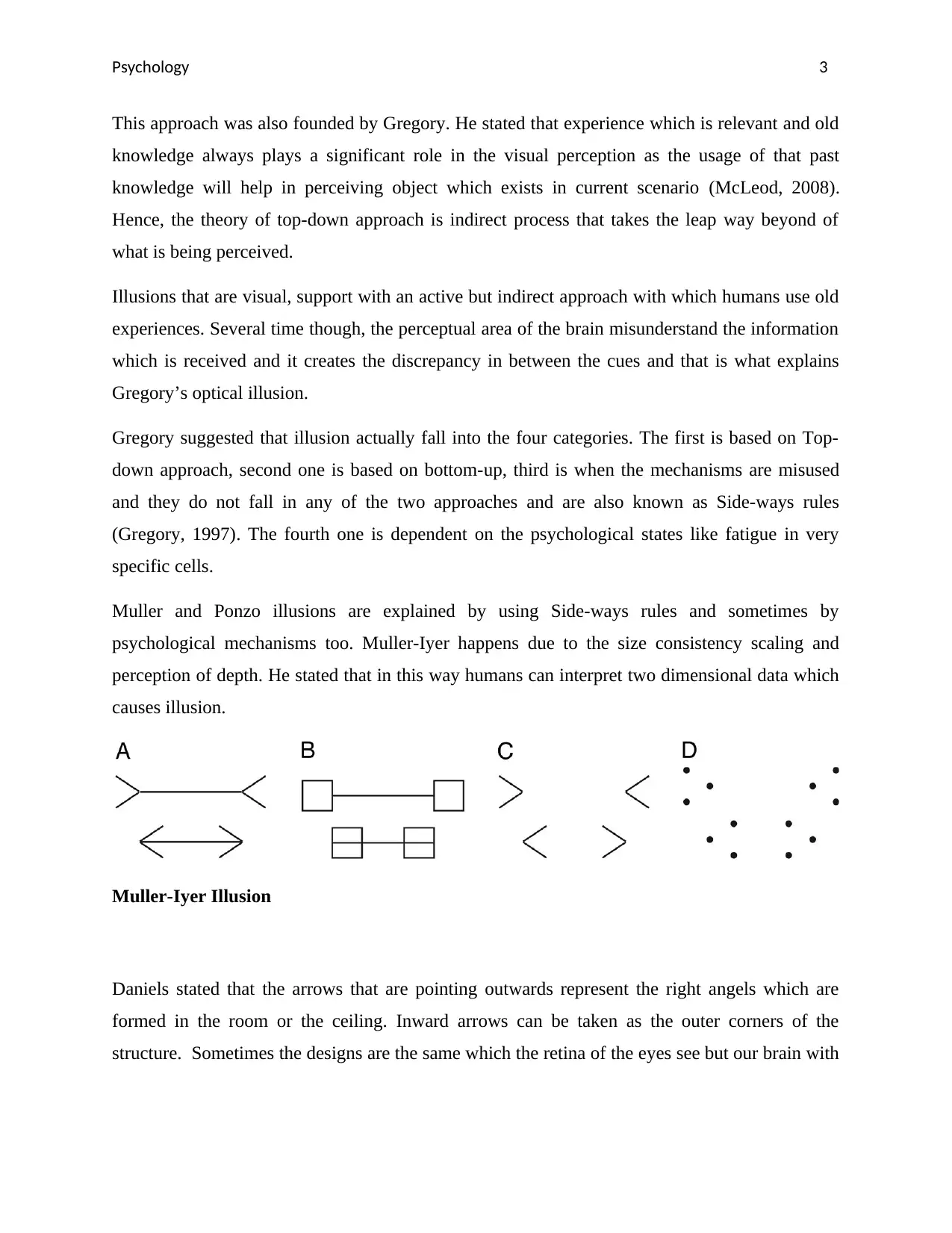
Psychology 3
This approach was also founded by Gregory. He stated that experience which is relevant and old
knowledge always plays a significant role in the visual perception as the usage of that past
knowledge will help in perceiving object which exists in current scenario (McLeod, 2008).
Hence, the theory of top-down approach is indirect process that takes the leap way beyond of
what is being perceived.
Illusions that are visual, support with an active but indirect approach with which humans use old
experiences. Several time though, the perceptual area of the brain misunderstand the information
which is received and it creates the discrepancy in between the cues and that is what explains
Gregory’s optical illusion.
Gregory suggested that illusion actually fall into the four categories. The first is based on Top-
down approach, second one is based on bottom-up, third is when the mechanisms are misused
and they do not fall in any of the two approaches and are also known as Side-ways rules
(Gregory, 1997). The fourth one is dependent on the psychological states like fatigue in very
specific cells.
Muller and Ponzo illusions are explained by using Side-ways rules and sometimes by
psychological mechanisms too. Muller-Iyer happens due to the size consistency scaling and
perception of depth. He stated that in this way humans can interpret two dimensional data which
causes illusion.
Muller-Iyer Illusion
Daniels stated that the arrows that are pointing outwards represent the right angels which are
formed in the room or the ceiling. Inward arrows can be taken as the outer corners of the
structure. Sometimes the designs are the same which the retina of the eyes see but our brain with
This approach was also founded by Gregory. He stated that experience which is relevant and old
knowledge always plays a significant role in the visual perception as the usage of that past
knowledge will help in perceiving object which exists in current scenario (McLeod, 2008).
Hence, the theory of top-down approach is indirect process that takes the leap way beyond of
what is being perceived.
Illusions that are visual, support with an active but indirect approach with which humans use old
experiences. Several time though, the perceptual area of the brain misunderstand the information
which is received and it creates the discrepancy in between the cues and that is what explains
Gregory’s optical illusion.
Gregory suggested that illusion actually fall into the four categories. The first is based on Top-
down approach, second one is based on bottom-up, third is when the mechanisms are misused
and they do not fall in any of the two approaches and are also known as Side-ways rules
(Gregory, 1997). The fourth one is dependent on the psychological states like fatigue in very
specific cells.
Muller and Ponzo illusions are explained by using Side-ways rules and sometimes by
psychological mechanisms too. Muller-Iyer happens due to the size consistency scaling and
perception of depth. He stated that in this way humans can interpret two dimensional data which
causes illusion.
Muller-Iyer Illusion
Daniels stated that the arrows that are pointing outwards represent the right angels which are
formed in the room or the ceiling. Inward arrows can be taken as the outer corners of the
structure. Sometimes the designs are the same which the retina of the eyes see but our brain with
Paraphrase This Document
Need a fresh take? Get an instant paraphrase of this document with our AI Paraphraser
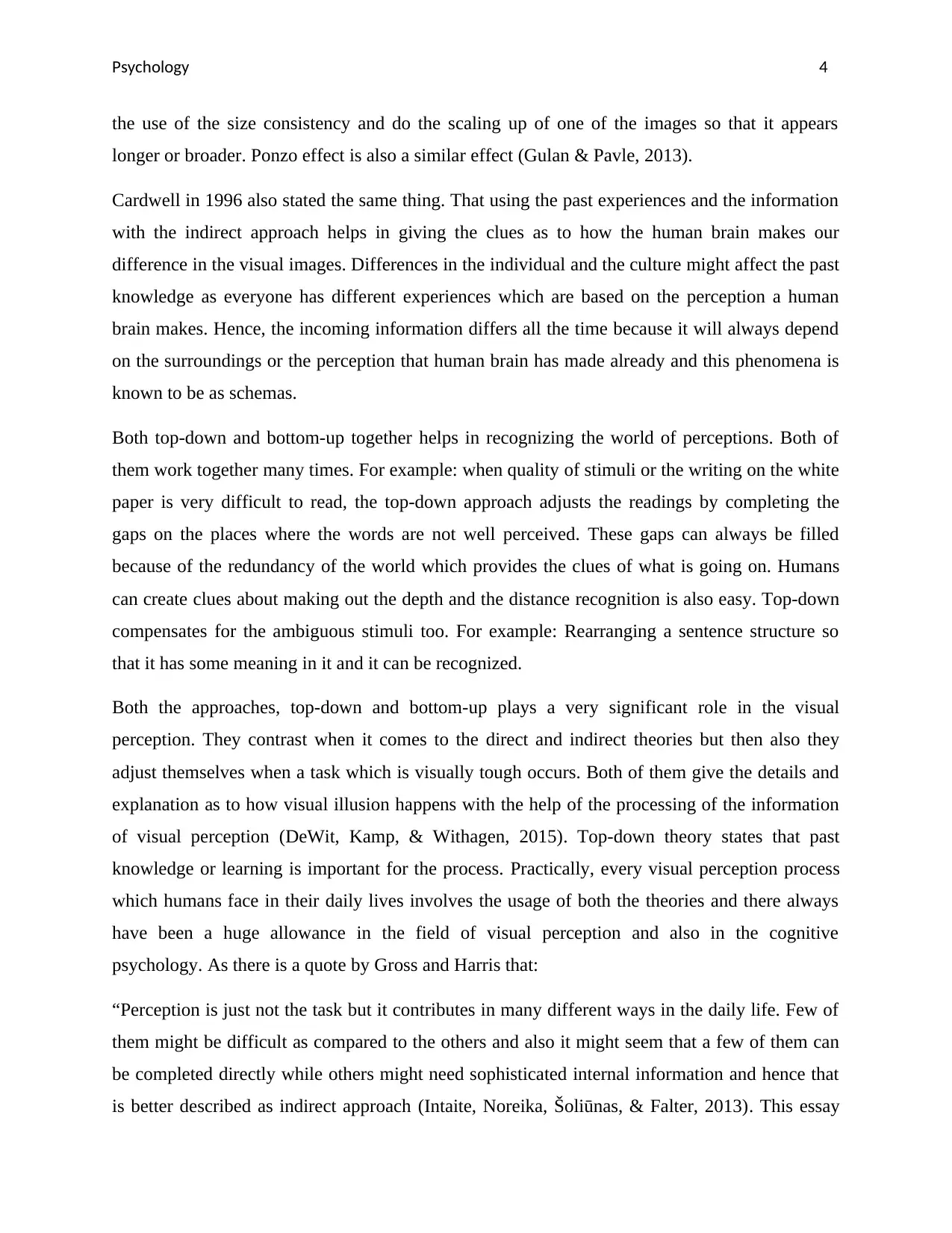
Psychology 4
the use of the size consistency and do the scaling up of one of the images so that it appears
longer or broader. Ponzo effect is also a similar effect (Gulan & Pavle, 2013).
Cardwell in 1996 also stated the same thing. That using the past experiences and the information
with the indirect approach helps in giving the clues as to how the human brain makes our
difference in the visual images. Differences in the individual and the culture might affect the past
knowledge as everyone has different experiences which are based on the perception a human
brain makes. Hence, the incoming information differs all the time because it will always depend
on the surroundings or the perception that human brain has made already and this phenomena is
known to be as schemas.
Both top-down and bottom-up together helps in recognizing the world of perceptions. Both of
them work together many times. For example: when quality of stimuli or the writing on the white
paper is very difficult to read, the top-down approach adjusts the readings by completing the
gaps on the places where the words are not well perceived. These gaps can always be filled
because of the redundancy of the world which provides the clues of what is going on. Humans
can create clues about making out the depth and the distance recognition is also easy. Top-down
compensates for the ambiguous stimuli too. For example: Rearranging a sentence structure so
that it has some meaning in it and it can be recognized.
Both the approaches, top-down and bottom-up plays a very significant role in the visual
perception. They contrast when it comes to the direct and indirect theories but then also they
adjust themselves when a task which is visually tough occurs. Both of them give the details and
explanation as to how visual illusion happens with the help of the processing of the information
of visual perception (DeWit, Kamp, & Withagen, 2015). Top-down theory states that past
knowledge or learning is important for the process. Practically, every visual perception process
which humans face in their daily lives involves the usage of both the theories and there always
have been a huge allowance in the field of visual perception and also in the cognitive
psychology. As there is a quote by Gross and Harris that:
“Perception is just not the task but it contributes in many different ways in the daily life. Few of
them might be difficult as compared to the others and also it might seem that a few of them can
be completed directly while others might need sophisticated internal information and hence that
is better described as indirect approach (Intaite, Noreika, Šoliūnas, & Falter, 2013). This essay
the use of the size consistency and do the scaling up of one of the images so that it appears
longer or broader. Ponzo effect is also a similar effect (Gulan & Pavle, 2013).
Cardwell in 1996 also stated the same thing. That using the past experiences and the information
with the indirect approach helps in giving the clues as to how the human brain makes our
difference in the visual images. Differences in the individual and the culture might affect the past
knowledge as everyone has different experiences which are based on the perception a human
brain makes. Hence, the incoming information differs all the time because it will always depend
on the surroundings or the perception that human brain has made already and this phenomena is
known to be as schemas.
Both top-down and bottom-up together helps in recognizing the world of perceptions. Both of
them work together many times. For example: when quality of stimuli or the writing on the white
paper is very difficult to read, the top-down approach adjusts the readings by completing the
gaps on the places where the words are not well perceived. These gaps can always be filled
because of the redundancy of the world which provides the clues of what is going on. Humans
can create clues about making out the depth and the distance recognition is also easy. Top-down
compensates for the ambiguous stimuli too. For example: Rearranging a sentence structure so
that it has some meaning in it and it can be recognized.
Both the approaches, top-down and bottom-up plays a very significant role in the visual
perception. They contrast when it comes to the direct and indirect theories but then also they
adjust themselves when a task which is visually tough occurs. Both of them give the details and
explanation as to how visual illusion happens with the help of the processing of the information
of visual perception (DeWit, Kamp, & Withagen, 2015). Top-down theory states that past
knowledge or learning is important for the process. Practically, every visual perception process
which humans face in their daily lives involves the usage of both the theories and there always
have been a huge allowance in the field of visual perception and also in the cognitive
psychology. As there is a quote by Gross and Harris that:
“Perception is just not the task but it contributes in many different ways in the daily life. Few of
them might be difficult as compared to the others and also it might seem that a few of them can
be completed directly while others might need sophisticated internal information and hence that
is better described as indirect approach (Intaite, Noreika, Šoliūnas, & Falter, 2013). This essay
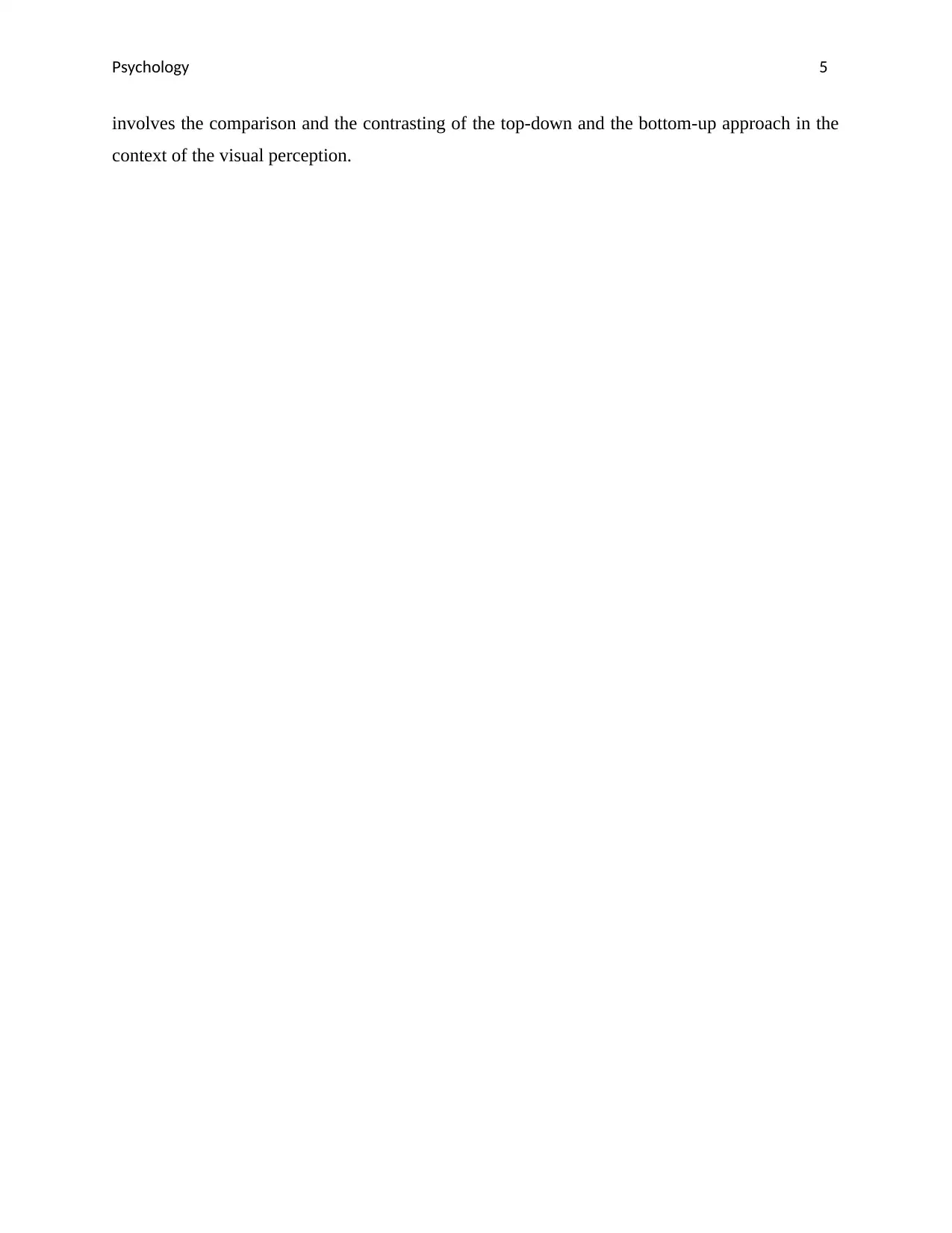
Psychology 5
involves the comparison and the contrasting of the top-down and the bottom-up approach in the
context of the visual perception.
involves the comparison and the contrasting of the top-down and the bottom-up approach in the
context of the visual perception.
⊘ This is a preview!⊘
Do you want full access?
Subscribe today to unlock all pages.

Trusted by 1+ million students worldwide
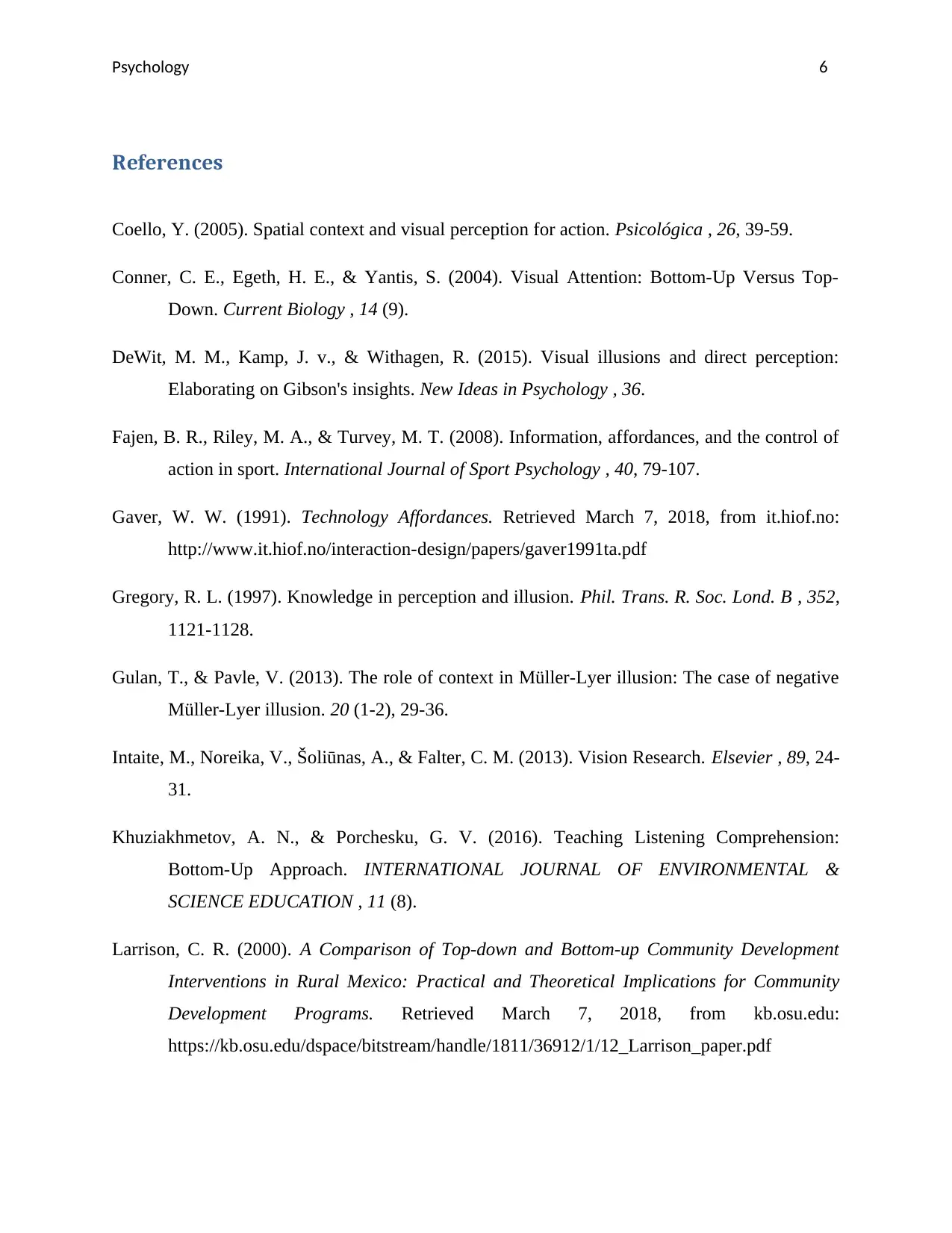
Psychology 6
References
Coello, Y. (2005). Spatial context and visual perception for action. Psicológica , 26, 39-59.
Conner, C. E., Egeth, H. E., & Yantis, S. (2004). Visual Attention: Bottom-Up Versus Top-
Down. Current Biology , 14 (9).
DeWit, M. M., Kamp, J. v., & Withagen, R. (2015). Visual illusions and direct perception:
Elaborating on Gibson's insights. New Ideas in Psychology , 36.
Fajen, B. R., Riley, M. A., & Turvey, M. T. (2008). Information, affordances, and the control of
action in sport. International Journal of Sport Psychology , 40, 79-107.
Gaver, W. W. (1991). Technology Affordances. Retrieved March 7, 2018, from it.hiof.no:
http://www.it.hiof.no/interaction-design/papers/gaver1991ta.pdf
Gregory, R. L. (1997). Knowledge in perception and illusion. Phil. Trans. R. Soc. Lond. B , 352,
1121-1128.
Gulan, T., & Pavle, V. (2013). The role of context in Müller-Lyer illusion: The case of negative
Müller-Lyer illusion. 20 (1-2), 29-36.
Intaite, M., Noreika, V., Šoliūnas, A., & Falter, C. M. (2013). Vision Research. Elsevier , 89, 24-
31.
Khuziakhmetov, A. N., & Porchesku, G. V. (2016). Teaching Listening Comprehension:
Bottom-Up Approach. INTERNATIONAL JOURNAL OF ENVIRONMENTAL &
SCIENCE EDUCATION , 11 (8).
Larrison, C. R. (2000). A Comparison of Top-down and Bottom-up Community Development
Interventions in Rural Mexico: Practical and Theoretical Implications for Community
Development Programs. Retrieved March 7, 2018, from kb.osu.edu:
https://kb.osu.edu/dspace/bitstream/handle/1811/36912/1/12_Larrison_paper.pdf
References
Coello, Y. (2005). Spatial context and visual perception for action. Psicológica , 26, 39-59.
Conner, C. E., Egeth, H. E., & Yantis, S. (2004). Visual Attention: Bottom-Up Versus Top-
Down. Current Biology , 14 (9).
DeWit, M. M., Kamp, J. v., & Withagen, R. (2015). Visual illusions and direct perception:
Elaborating on Gibson's insights. New Ideas in Psychology , 36.
Fajen, B. R., Riley, M. A., & Turvey, M. T. (2008). Information, affordances, and the control of
action in sport. International Journal of Sport Psychology , 40, 79-107.
Gaver, W. W. (1991). Technology Affordances. Retrieved March 7, 2018, from it.hiof.no:
http://www.it.hiof.no/interaction-design/papers/gaver1991ta.pdf
Gregory, R. L. (1997). Knowledge in perception and illusion. Phil. Trans. R. Soc. Lond. B , 352,
1121-1128.
Gulan, T., & Pavle, V. (2013). The role of context in Müller-Lyer illusion: The case of negative
Müller-Lyer illusion. 20 (1-2), 29-36.
Intaite, M., Noreika, V., Šoliūnas, A., & Falter, C. M. (2013). Vision Research. Elsevier , 89, 24-
31.
Khuziakhmetov, A. N., & Porchesku, G. V. (2016). Teaching Listening Comprehension:
Bottom-Up Approach. INTERNATIONAL JOURNAL OF ENVIRONMENTAL &
SCIENCE EDUCATION , 11 (8).
Larrison, C. R. (2000). A Comparison of Top-down and Bottom-up Community Development
Interventions in Rural Mexico: Practical and Theoretical Implications for Community
Development Programs. Retrieved March 7, 2018, from kb.osu.edu:
https://kb.osu.edu/dspace/bitstream/handle/1811/36912/1/12_Larrison_paper.pdf
Paraphrase This Document
Need a fresh take? Get an instant paraphrase of this document with our AI Paraphraser
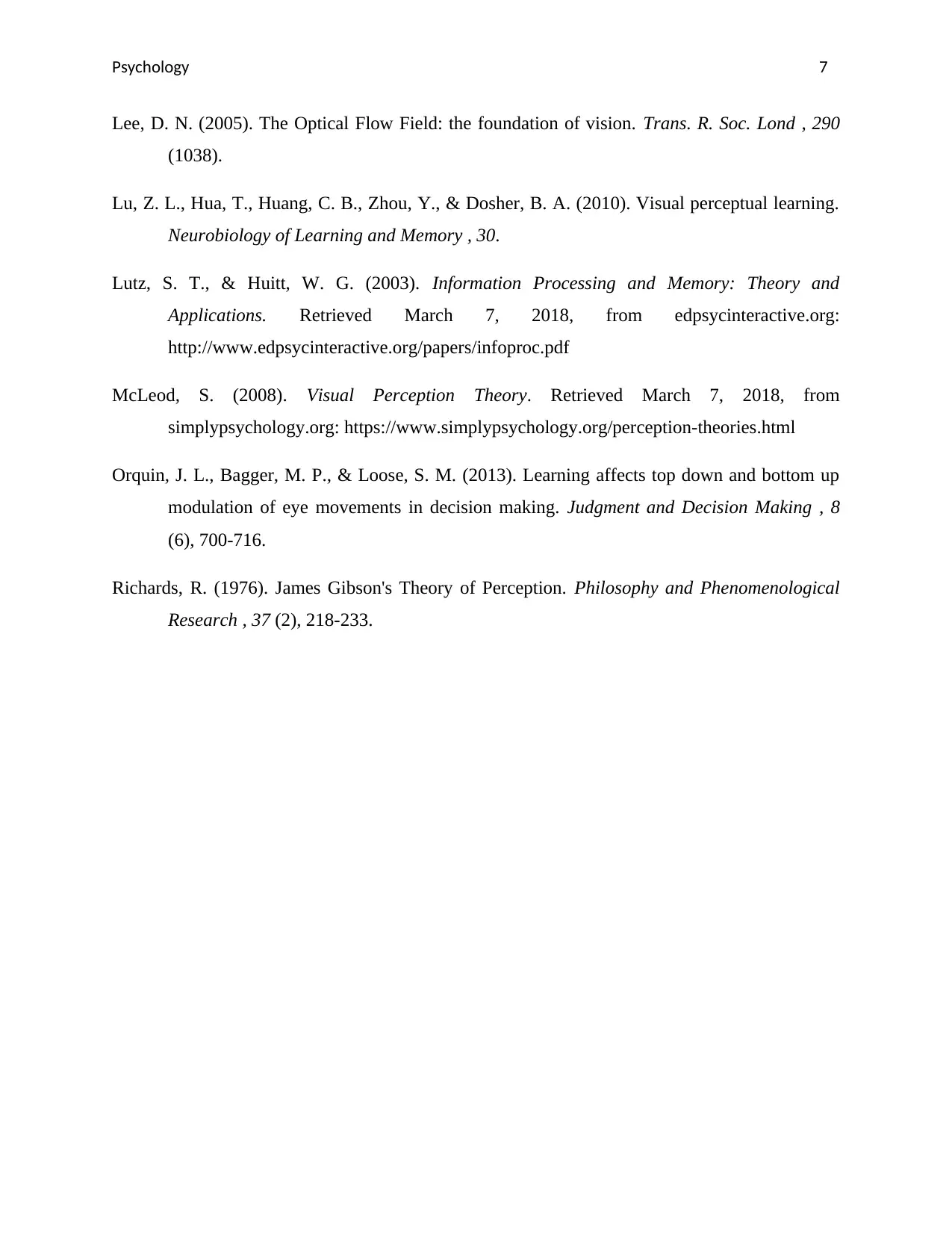
Psychology 7
Lee, D. N. (2005). The Optical Flow Field: the foundation of vision. Trans. R. Soc. Lond , 290
(1038).
Lu, Z. L., Hua, T., Huang, C. B., Zhou, Y., & Dosher, B. A. (2010). Visual perceptual learning.
Neurobiology of Learning and Memory , 30.
Lutz, S. T., & Huitt, W. G. (2003). Information Processing and Memory: Theory and
Applications. Retrieved March 7, 2018, from edpsycinteractive.org:
http://www.edpsycinteractive.org/papers/infoproc.pdf
McLeod, S. (2008). Visual Perception Theory. Retrieved March 7, 2018, from
simplypsychology.org: https://www.simplypsychology.org/perception-theories.html
Orquin, J. L., Bagger, M. P., & Loose, S. M. (2013). Learning affects top down and bottom up
modulation of eye movements in decision making. Judgment and Decision Making , 8
(6), 700-716.
Richards, R. (1976). James Gibson's Theory of Perception. Philosophy and Phenomenological
Research , 37 (2), 218-233.
Lee, D. N. (2005). The Optical Flow Field: the foundation of vision. Trans. R. Soc. Lond , 290
(1038).
Lu, Z. L., Hua, T., Huang, C. B., Zhou, Y., & Dosher, B. A. (2010). Visual perceptual learning.
Neurobiology of Learning and Memory , 30.
Lutz, S. T., & Huitt, W. G. (2003). Information Processing and Memory: Theory and
Applications. Retrieved March 7, 2018, from edpsycinteractive.org:
http://www.edpsycinteractive.org/papers/infoproc.pdf
McLeod, S. (2008). Visual Perception Theory. Retrieved March 7, 2018, from
simplypsychology.org: https://www.simplypsychology.org/perception-theories.html
Orquin, J. L., Bagger, M. P., & Loose, S. M. (2013). Learning affects top down and bottom up
modulation of eye movements in decision making. Judgment and Decision Making , 8
(6), 700-716.
Richards, R. (1976). James Gibson's Theory of Perception. Philosophy and Phenomenological
Research , 37 (2), 218-233.
1 out of 8
Related Documents
Your All-in-One AI-Powered Toolkit for Academic Success.
+13062052269
info@desklib.com
Available 24*7 on WhatsApp / Email
![[object Object]](/_next/static/media/star-bottom.7253800d.svg)
Unlock your academic potential
Copyright © 2020–2025 A2Z Services. All Rights Reserved. Developed and managed by ZUCOL.





